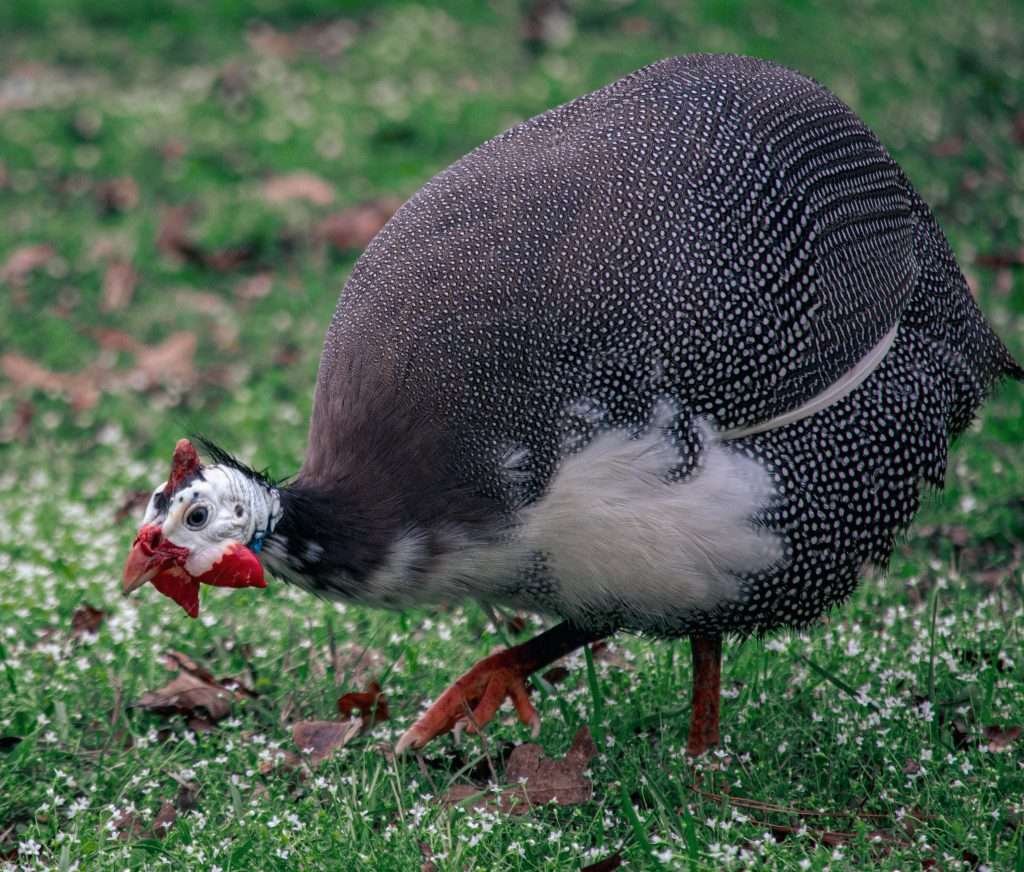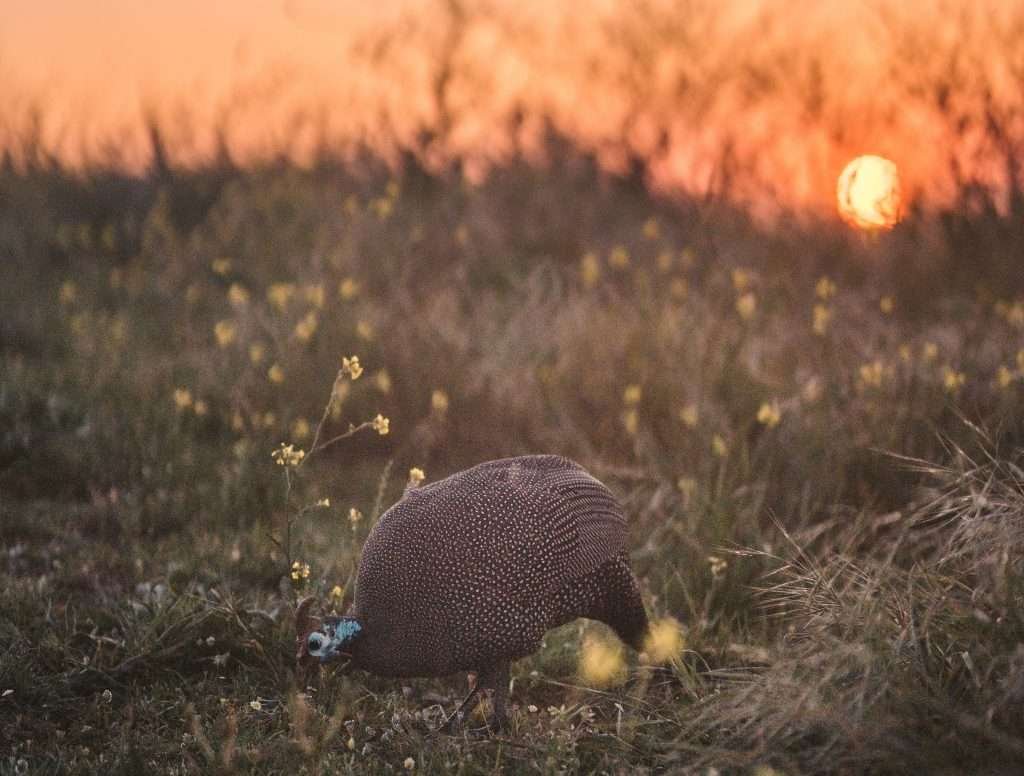If you are looking for a natural pest control solution and have space at your property for free range fowl then a Guinea hen may just be a great choice for you!

Guinea hens are interesting conversation starters and are fabulous for natural pest control. They make an ideal addition to a homestead environment.
Our comprehensive and detailed overview of this breed will inform you of the characteristics of Guinea hens and enable you to decide whether they are the right fit for your property.
What this article covers
This is a long article, so below are some quick links. Click any of them to go straight to that section – or just carry on reading for the full guide!
Guinea Hen Characteristics
| Lifespan: | 10-15 years. |
| Weight: | 2-5lb. |
| Color: | Pearl, white, lavender, royal purple, coral blue, buff, chocolate and bronze. |
| Egg Production: | 2-3 per week. |
| Egg Color: | Brown with dark speckles. |
| Egg Size: | Half the size of a chicken egg. |
| Child Friendly | No |
| Broody | No |
| Suitable for Wet Environments | Yes |
| Suitable for Cold Environments | Yes |
| Suitable for Hot Environments | Yes |
| Cost of Chicks (approx USD) | Check Latest Price Here |
History of Guinea fowl
Guinea fowl, of which there are eight distinct species at present, are all natives of the African continent, or of the adjacent Island of Madagascar.
They constitute the genus Numida, and the West African wild species, N. Meleagris, is generally regarded as the origin of the domestic breed also known as the Helmeted Guineafowl.
This bird is found wild in Western Africa, ranging from Gambia southwards, through to the Gaboon. They are also said to exist in the Cape de Verd Islands.
The Guinea fowl was of high value to the Romans for use in public and private feasts and was most likely traded through Egyptian routes to Rome.
The Spanish brought guinea fowl to the Americas in the early 1500’s, soon after the arrival of Christopher Columbus.
Personality of Guinea hens
Guinea Hens are very active birds and are ferocious hunters of bugs and insects. They do not like small spaces and need room to move around and free range.
These birds can fly so don’t be surprised if you find them up a tree or on top of the coop!
They are noisy birds and therefore make great ‘guard’ birds. They love to alert of potential dangers no matter how insignificant the danger may be.
Guinea hens are very sociable and will all move around together as a flock. If one fowl becomes separated from the group it will keep calling out to the others until they are reunited – this reiterates the noise potential and vocal nature of this breed.
Guinea hens do not like being handled or touched and are not suitable as pets for children that want to touch them. They will ‘scream’ at you until they are put down!
The males can be particularly aggressive to other fowl and are very protective of their females and young. Unlike the mothers, they do however make nurturing parents and the males take a very active role in looking after their keets (Guinea fowl young).
What are Guinea hens like as egg-layers?
Guinea hens are seasonal layers mainly lay eggs between March-April and September-October. If you are looking for a bird that is going to give you year round eggs then a Guinea hen is not for you.
Guinea hens don’t typically use nesting boxes so keep them in the coop until noon so you can locate any eggs laid during the season. If Guinea hens are left to free range during egg laying season they will likely lay their eggs in a hidden and secret location – so good luck finding them! The Guinea fowl are also communal layers meaning they like to lay together in the same spot!
Their eggs are similar in appearance to chicken eggs but slightly more pointed at one end of the egg. They are light brown to brown with dark brown spots. The eggs are a little higher in protein and fat than chicken eggs but are rich and creamy in texture and taste like duck eggs.
Appearance of Guinea hens
There are several different types of guinea fowl, but the most often seen and ‘domesticated’ is the helmeted guinea fowl.
The types are:
- White-breasted – mainly found in West Africa. Due to habitat loss, it is considered a vulnerable bird according to the International Union for Conservation of Nature.
- Black – confined to central Africa.
- Vulturine – largest of the Guineas. Has a very striking appearance, can become quite tame. Needs large groups to thrive.
- Helmeted – most common ‘domesticated’ type. Has a central knob on the skull leading to the ‘helmet’ appearance.
- Plumed – little is known of this bird which is found mainly in central Africa.
- Crested – the most aggressive type; may chase people, including their owners. Has a ‘curly mop’ on the head.

Guinea fowl come in various colors. Some of their many color varieties are pearl, white, royal purple, coral blue, buff, chocolate, and bronze. However, not all of these colors are recognized by the official standards.
In the US, only the helmeted Guinea fowl is recognized. The colors of the bird that are recognized are lavender, pearl, and white.
In Australia the breed is recognised with lavender, pearl, white, cinnamon, and pied coloration.
Guinea is about the size of a large chicken and, when fully grown, will weigh approximately 4lb. The Head and neck area is bare skin, which helps to regulate temperature.
The coloration of the skin is a combination of blue, red, and black hues, giving the Guinea fowl a clown-like appearance.
With short, rounded wings and a short tail, it looks oval-shaped.
Their beak is short but curved and very stout. The wattles on the male are larger than the female, some fowl do not even have wattles.
These birds do not reach sexual maturity until their second year which makes it very difficult to sex them as young.
The male fowl and female fowl make different sounds. The female will call in two syllable sounds with what sounds like ‘buck-wheat’, ‘put-rock’ or ‘qua-track’. The males will only emit a one syllable call.
Pros and Cons of Guinea hens
| Pros 👍 | Cons 👎 |
| ✔ Great as a natural pest control solution | ❌ Noisy |
| ✔ Natural alert system for predators and intruders | ❌ Not suitable as pets for children |
| ✔ Long lifespan | ❌ Can be aggressive |
| ✔ Tolerant most weather conditions – particularly once maturity has been reached | ❌ Seasonal egg layers |
| ✔ Resistant to disease | ❌ Need space to free range and are semi wild |
| ✔ Unique appearance | ❌ Can be easier prey for predators due to not wanting to be confined |
| ✔ Can be used for meat | ❌ Can fly well so will need appropriate fencing |
Guinea hen health
These birds are hardy but dislike snowy and very wet climates.
If you are keeping them in these climates then they need to have adequate shelter and food if they cannot supplement with their usual foraging activity.
Guinea hens are tough and hardy once they become adults. They are very disease resistant and are only generally affected by the usual lice, mites and parasites other poultry get.
Feeding Guinea hens
Guinea fowl are omnivorous birds. Adult Guineas should be fed turkey or game feed with at least 16% protein. They will require more supplementary food in winter and less in summer when foraging food is more abundant. Don’t bother with pellet food or corn kernels as Guinea fowl are most likely to ignore them and do better on mashed feed.
The rest of their diet can be supplemented with bugs, grass and other titbits Guinea hens find when free ranging. They may also eat larger things such as small snakes and mice if they have the chance to. If your Guinea Hens eat greens then you should supply a bowl of insoluble grit for them such as oyster shells. This will help them digest the greens better. Also make sure that ample fresh water is always available to them.
Medicated feed is OK to use for Guinea keets, especially if the weather is hot and humid which encourages the growth of coccidia in the environment.

Coop requirements
Guinea hens spend very little time in the coop due to their need for free ranging. Each Guinea hen will need approximately 2-3 square feet each inside the coop.
For roosting space they will each need 8-10 inches and prefer to roost up high.
Guinea hens avoid using nesting boxes so don’t bother with these. They instinctively like to lay in hidden places so if you want to collect the eggs, confine them to their coop until around noon and they would have laid by then.
Guinea hens often like lingering longer in the evening so having a light on inside the coop encourages the guineas to move toward the light as sunlight fades. If the coop has an automatic door, set it to close a bit later to accommodate the Guinea fowl.
You will need a property with space for Guinea fowl to free range – remember they hate being cooped up and are a semi-wild bird. They do also fly so you will need fencing that is appropriate to retain them within the boundary of the area you allow them to free range.
If you have trees or anything off the ground, the Guinea hens will fly up for safety if they feel threatened.
Should you get a Guinea hen?
The Guinea fowl has been embraced by those looking to reduce their pesticide use as an effective form of pest control plus with the added benefits of eggs!
If you have room on your property for roaming and free range and are looking for an efficient bug hunter and a bird that’s interesting to look at, as well as alert you to intruders – then a Guinea hen is most likely a good choice for your property.
Guinea Hens For Sale
Cackle Hatchery supplies and delivers over 200 varieties of chicken breeds. Check out current supplies and prices for Guinea Hens here.
Shopping list of items needed to look after a Guinea hen
We have put together a shopping list below to help ensure your chickens are kept in an optimal health condition. Check out our list here:

